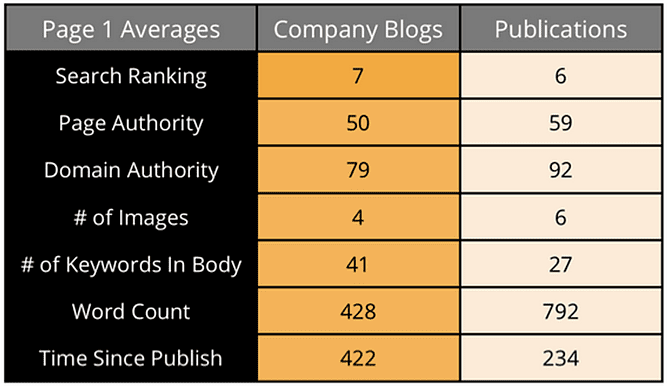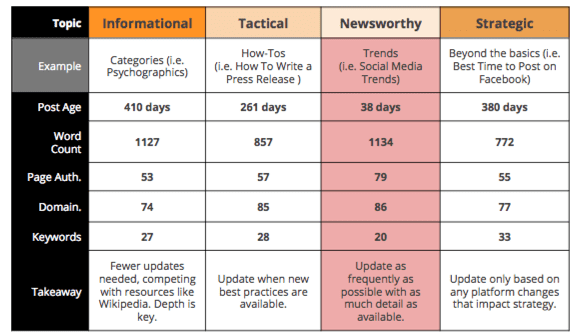In the shifting sands of SEO, there’s one constant: It’s much better to sit atop the SERPs than it is to rank on page two.
How much better? Nearly 30x better.
As you’ll see in the tables below, when it comes to ranking in search, publications — that is, actual news sites — still do it best.
The inbound marketing movement, however, has helped bridge the gap that divides brands and publications.
Thanks to the rise in inbound practices like content marketing and brand journalism, the articles published by brands have begun to evidence some of the hallmarks that make news sites so Google-friendly.
Do content-driven brands skew closer to publications, or are their marketing roots still showing?
We analyzed 200 posts that ranked on page one of Google for terms related to the marketing industry, each of which generate at least 500 monthly searches.
Of course, publishers, whether marketers or journalists, have direct control over only a handful of Google’s evolving ranking criteria.
The factors that impact search results differ according to topic and keyword.
For example, if you want to influence page and domain authority, you will find it akin to steering an ocean liner: It’s doable, provided you’re not in a hurry.
Thus, for the purposes of our analysis, we paid particular attention to the recency, content structure, and post quality.
These factors are largely within the publisher’s span of control.
Within this analysis, we kept the view more directional using a “broad stroke.” Why?
Because the search algorithms use machine learning to constantly adjust the weighting of each individual factor.
Here’s what we found.
Company Blogs and Publications Have Significantly Different Profiles
Our first test compared search performance by domain type: company blogs vs. publications (such as news or media sites).

On average, publications tend to rank higher than company blogs, with an average search ranking of approximately 5.8 (placement on SERP) whereas company blogs tend to rank around 7.
Looking at some key factors that impact search ranking, such as page authority and domain authority, we found that publications also tend to have more authority as a whole.
Logically, we should have seen this as a predictable byproduct of their role as a primary news source.
However, when it comes to the actual content structure and quality, publications also tend to include more images, fewer keywords, higher word count, and a more recent publication date on published articles for the same exact keywords as company blogs.
The trends we found in our sample data match trends in search engine algorithm updates.
These updates punish keyword stuffing while rewarding quality content, which is often measured by:
- Comprehensiveness (proxy: word count)
- Relevance (proxy: recency)
Content Categories Show “Brand Journalism” Is Toughest Category to Compete
Our second comparison looked at marketing terms ranking on page-one by topic: informational, tactical, newsworthy, and strategic.

We found that while evergreen, resource-quality content requires comprehensive exploration, informational content doesn’t need to be updated as regularly as other types of articles.
Tactical content, or instructional “how-to”-type articles, should be updated as new information is made available.
This is especially true when new developments occur that affect the guidance provided in the post.
Time-sensitive, breaking content is labeled Newsworthy in the table above. As you might expect, publications were particularly strong in this area.
Keywords and article length were less significant factors with news than with other types of content.
Predictably, recency and page/domain authority were paramount.
When it came to Strategic content, or in-depth and sophisticated pieces written for industry experts, brands were just as likely as publications to achieve a page one ranking.
As you can see by the highest keyword density, this is an area in which content marketers are likely focusing much their attention.
On balance, marketers compete most strongly in tactical and strategic content while facing stiffer competition in informational (Wikipedia) and newsworthy (publications) content.
How to Close the Gap in Rankings
If they want to neutralize the natural advantage publications have in the areas of domain / page authority and linking domains, marketers should:
1) Focus on Depth & Quality
Indicators of content depth and quality, such as word count, number of images, and user behavioral signals (e.g. bounce rates), will continue to impact search rankings.
The more thoroughly researched and better crafted the piece of content is, the higher the likelihood of it being able to outrank competing brands and publications alike.
2) Build Strong Content Distribution Channels
In order to increase key factors such as user behavioral signals, it is important to develop strong distribution channels across email and social media.
By driving referral traffic through your own distribution channels, you can increase the number of users consuming the content, referencing it through links, and sharing it through social media — creating an exponential lift.
3) Strategically Optimize Content Mix
Your competition on search isn’t necessarily the same as your competition in business.
Depending on the type of content you are publishing, your search competition can range from companies in your industry to news sites to Wikipedia.
Create a strategy unique to each topic in your content mix.
4) Develop a Schedule for Post Refreshes
Recency matters. Be sure to refresh “old” content as new information becomes available.
This will enhance relevance and help trigger social shares.
Build a list of published posts that are likely to be affected by future developments (e.g. “Best Times To Post Content To Social Media Accounts”).
Then later, be sure to revisit those posts as the topics evolve.
Conclusion
It’s tempting to get distracted by speculation surrounding the latest SEO algorithm updates.
Don’t. Remember that the core principles behind SEO and rankings have gone largely unchanged.
Content quality, depth, and freshness are still the pillars for effective search strategies, while a strong distribution channel can help accelerate success.
Publications have always been aware of these fundamentals.
As brands begin to embody journalistic traits, they should also look to news outlets to help guide their SEO strategy.
This article was originally written by Victoria Young while employed at HubSpot, and republished with permission.
Images provided by HubSpot under their own licenses.
Disclaimer: The views and opinions stated in this post are that of the author, and Return On Now may or may not agree with any or all of the commentary.
Updated October 29, 2025




